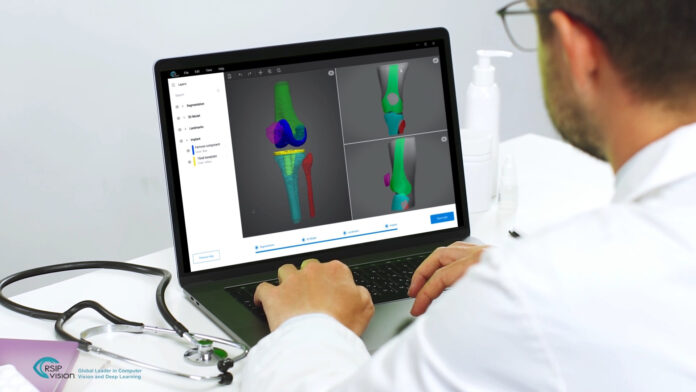
TEL AVIV, Israel & SAN JOSE, Calif.– RSIP Vision, a clinically proven leader in real-world AI solutions for medical image analysis, announced today a novel 2D to 3D registration module that will improve the execution of Orthopedic surgeries, such as total hip arthroplasty. Utilizing a proprietary neural network, trained on patient-specific imaging, this module will enable powerful, automated intra-operative assessments in real time of the true location and positioning of the implants and bones increasing accuracy and improving the surgery execution. This is achieved by matching a pre-operative CT to intraoperative fluoroscopy and giving the surgeon a real time indication accordingly. The solution aims to increase the efficiency of both the planning and execution phases of hip replacement surgery through automated landmark detection and measurement of anatomical relationships.
The new module joins a vast suite of orthopedic image analysis tools for pre-operative planning and intraoperative navigation developed by RSIP Vision. It leverages a unique, AI-based, patient-specific image registration algorithm developed in RSIP’s innovation lab and is being offered to the leading implant and medical imaging companies to power specific, intraoperative procedures, such as hip replacement surgical solutions. In parallel to the initial capability of 2D-to-3D femur and pelvis registration, RSIP is developing additional modules for implant hardware registration as well as a 3D anatomical measurements suite, to be offered in the near future.
Total joint arthroplasty is one of the most common procedures in orthopedics. According to the Agency for Healthcare Research and Quality, more than 450,000 total hip replacements are performed each year in the United States. While both the outcome quality and volume of the procedure enjoy a steady growth, surgeons are continuing to recognize the importance of patient-specific planning and functional component positioning. To extend the longevity of implants and accommodate younger, more active patients, surgeons are utilizing these types of emerging technologies with outcomes in the range of submillimeter accuracy.
As the surgeon moves throughout the various stages of the procedure, the system recognizes and updates changes from the pre-operative condition to confirm that the components are in their desirable positions. This novel AI-based approach will be unique in its ability to robustly register and detect anatomical landmarks in real time, opening a host of advanced applications.
“These days, we see more patients with active lifestyles going through orthopedics surgery, accordingly the need for accurate and successful orthopedic surgeries is increasing. These patients have years and years of active life beyond them and every millimeter in the final positioning counts,” said Dr. Shai Factor, an orthopedic surgeon at Tel Aviv Sourasky Medical Center in Israel. Getting to such accuracy is not easy to achieve, but it is vital, so today we rely on our personal experience and eyeballing to get that done. This technology will assist and guide us, the surgeons, throughout the procedure, providing the essential feedback regarding anatomical measurements and implant positioning. I believe it will improve our surgeries’ accuracy and may lead to better clinical outcome.”

